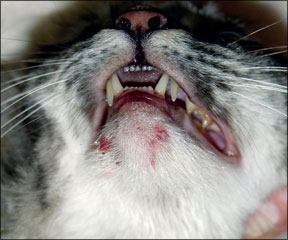Some of the most peaceful moments of your day are spent sitting quietly with your cat, stroking her gently, peering into her gorgeous eyes. However, the serenity can well be interrupted if you happen to notice a crop of tiny, mean-looking little black spots on the otherwise lovely animals chin and lips. What youre apt to be observing are blackheads, the signs of feline acne, a dermatologic condition that affects male and female cats of all ages and breeds and could warrant a visit to your veterinarian. Bev Caldwell 288 According to William H. Miller, Jr., VMD, medical director of the Companion Animal Hospital at Cornell Universitys College of Veterinary Medicine, the emergence of blackheads usually represents nothing more than a cosmetic problem. However, he points out, feline acne – which appears only on the chin and lips – can evolve into a serious health issue if the benign blackheads turn into pus-filled boils (furuncles) that may signal the presence of a deep-seated bacterial or fungal infection. Dr. Miller makes an important distinction between “simple” and “difficult” acne. “You dont have to routinely examine your cats face to discover blackheads,” he says. “Unless youre visually impaired, youll notice them.” If the cat has a half-dozen or even as many as 20 blackheads, he says, there is little cause for concern. But some cats will have hundreds of them. In that case, its time for a visit to the veterinarian for proper prophylaxis and specific acne treatment. Painful Process A blackhead forms when excess keratin – an insoluble protein that is the chief constituent of hair – collects in a follicle, the slender, tubular shaft that contains the root of a hair. Over time, a sufficient collection of oily keratin debris can plug the hair follicle. “If there are bacteria, yeast or other infectious agents sealed in by the plug,” says Dr. Miller, “a furuncle may develop. Then there is pus down below the surface of the skin, and that can spread from one pimple to another and eventually to the whole chin. This happens rarely, but when it does, the infection can progress to a systemic illness.” A more common and immediately pressing problem, he notes, is the discomfort caused by the presence of a plugged follicle and accompanying inflammation. “These lesions are very tender, very painful,” says Dr. Miller, “and if a cat keeps banging her chin on her food bowl, she may eventually go off her food.” Feline acne, he points out, can then become an issue that affects the cats overall health. Possible Causes The cause or causes of feline acne are unknown, although a variety of veterinary sources offer a range of explanations for the condition. Commonly suspected causes include dirty food and water bowls, allergies, genetic disposition, poor grooming habits, clogged hair follicles resulting from inadequate shedding, defects in keratin production and the overproduction of sebum, a waxy substance produced by the sebaceous glands in the skin. The use of plastic feeding bowls is often cited as a major cause, the idea being that plastic tends to harbor harmful bacteria, while glass, metal and ceramic bowls that can be easily washed do not pose this hazard. Dr. Miller disputes some of these notions. Regarding grooming habits, for example, he observes: “If your kitty habitually splashes food all over itself as it eats, thats not going to cause acne. Even the most fastidious cats get it.” And what about the plastic dishes? “Thats an old wives tale,” says Dr. Miller. “Certain sensitive cats can experience contact dermatitis from plastic, and they should be using glass or stainless steel. But there is no direct causal link between acne and the use of plastic bowls.” He is also skeptical regarding the common suggestion that stress can cause feline acne. “I suppose there could be a connection between acne and chronic, intense stress,” he says, “but then you wouldnt just have acne – youd have a cat thats a basket case. The bottom line is that we just dont know what causes this condition. There is no one trigger.” Acne Treatment Simple acne can be safely ignored, says Dr. Miller. “The blackheads come and go,” he notes. “The great majority of cats never get them, some get them seasonally and some get them once and never again.” If the attentive cat owner wants to treat feline acne at home, he says, this can be achieved through the gentle application to the animals lips and chin of such over-the-counter products as hydrogen peroxide, alcohol, mouthwash or medicated acne pads designed for human use. Veterinary treatment of serious feline acne marked by the presence of a large pimple or furuncle is considerably more complicated. The first objective, says Dr. Miller, is to determine whether there is a true infection and, if so, whether its source is bacterial or fungal. Medication will be determined accordingly, with appropriate antibacterial or antifungal drugs used either topically or – if the infection appears to be severe – systemically.



